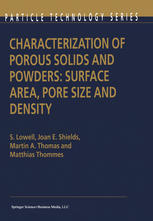

Most ebook files are in PDF format, so you can easily read them using various software such as Foxit Reader or directly on the Google Chrome browser.
Some ebook files are released by publishers in other formats such as .awz, .mobi, .epub, .fb2, etc. You may need to install specific software to read these formats on mobile/PC, such as Calibre.
Please read the tutorial at this link: https://ebookbell.com/faq
We offer FREE conversion to the popular formats you request; however, this may take some time. Therefore, right after payment, please email us, and we will try to provide the service as quickly as possible.
For some exceptional file formats or broken links (if any), please refrain from opening any disputes. Instead, email us first, and we will try to assist within a maximum of 6 hours.
EbookBell Team

5.0
50 reviewsThe growth of interest in newly developed porous materials has prompted the writing of this book for those who have the need to make meaningful measurements without the benefit of years of experience. One might consider this new book as the 4th edition of "Powder Surface Area and Porosity" (Lowell & Shields), but for this new edition we set out to incorporate recent developments in the understanding of fluids in many types of porous materials, not just powders. Based on this, we felt that it would be prudent to change the title to "Characterization of Porous Solids and Powders: Surface Area, Porosity and Density". This book gives a unique overview of principles associated with the characterization of solids with regard to their surface area, pore size, pore volume and density. It covers methods based on gas adsorption (both physi and chemisorption), mercury porosimetry and pycnometry. Not only are the theoretical and experimental basics of these techniques presented in detail but also, in light of the tremendous progress made in recent years in materials science and nanotechnology, the most recent developments are described. In particular, the application of classical theories and methods for pore size analysis are contrasted with the most advanced microscopic theories based on statistical mechanics (e.g. Density Functional Theory and Molecular Simulation). The characterization of heterogeneous catalysts is more prominent than in earlier editions; the sections on mercury porosimetry and particularly chemisorption have been updated and greatly expanded.